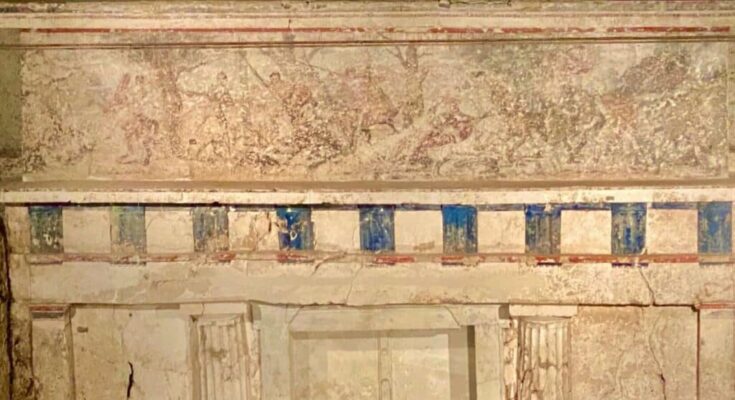
The tunic of Alexander the Great has been discovered in Greece according to an international team of archeologists and osteologists.
The scientists also revealed the identities of the occupants of the unspoiled 4th-century BCE Royal Tombs at Vergina in northern Greece.
The international team was comprised of scientists Juan Luis Arsuaga, Universidad Complutense de Madrid, Nicholas Brandmeir, West Virginia University and led by Antonis Bartsiokas of Democritus University in Thrace, Greece.
Discovery of the Royal Tombs and identification of the occupants
The burial system contains the remains of Alexander’s father, stepmother, half-siblings, and son. It also contains armor and other items belonging to the man himself.
While there has never been any doubt that the human skeletal remains found in Royal Tombs I, II, and III belong to close relatives of Alexander, scholars have spent almost half a century debating who exactly lies within each grave.
According to the latest findings, Tomb I belongs to Philip II, the father of Alexander the Great, while Tomb II belongs to Philip III Arrhidaeus, the son of Philip II.
“The scientific dispute over the identity of the buried skeletons dates back to 1977.” explains archeology professor Antonios Bartsiokas of the Democritus University of Thrace in an exclusive interview with Greek Reporter.
“Osteological data show that Tomb II belongs to Arrhidaeus, while Tomb I belongs to Philip II. There is also archaeological evidence to support this. For example, the skeleton in Tomb I shows a synostosis (fusion) of the thigh with the leg. This clearly indicates that this skeleton belongs to Alexander’s father, as Philip II was limping. Additionally, archeologists found a newborn in Tomb I, further evidence that it belongs to Philip II. Historical sources mention only one newborn, likely belonging to Cleopatra, the youngest of Philip’s seven wives. These findings prove that Tomb I belongs to Philip II.” notes Dr. Bartsiokas.

The fate of Philip II, Arrhidaeus, and Adea Eurydice
According to historian Arrianus and philosopher Plutarch, the bodyguard of Philip II, Pausanias, assassinated him only a few days after his wife, Cleopatra, gave birth. Almost immediately after the assassination, Olympias, the mother of Alexander the Great, killed Cleopatra and her baby, possibly by burning them alive as some theories note.
Bartsiokas also stated that the skeleton in Tomb II seems to show no signs of injury, which corresponds to the condition of Arrhidaeus, who likewise suffered no physical trauma. This contrasts with the skeleton of Philip II, who had four wounds, and Alexander the Great’s, who sustained ten wounds. Additionally, the way the body was cremated aligns with how Arrhidaeus and his wife, Adea Eurydice, are believed to have met their deaths.
Who was Philip III Arrhidaeus
Arrhidaeus was the son of Philip II of Macedon and his second wife, Philinna of Larissa. After Alexander’s death, the Macedonian army proclaimed Arrhidaeus king, naming him Philip III Arrhidaeus of Macedonia.
Philip III Arrhidaeus married Adea Eurydice, the daughter of Cynane. Following the assassination of Perdiccas in Egypt, Peithon assumed guardianship of Philip III Arrhidaeus.
Philip III Arrhidaeus and his wife, Adea Eurydice, returned to Macedonia under the protection of Antipater. After Antipater’s death in 319 BC, the guardianship of Arrhidaeus passed to Polyperchon. However, Adea Eurydice, alarmed by the arrival of Olympias in Macedonia, sought assistance from Cassander, the son of Antipater.
In an attempt to fend off the forces of Olympias and her ally, Aeacides, king of Epirus (her cousin), Philip III Arrhidaeus soldiers defected to Olympias. She then ordered the executions of both Philip III Arrhidaeus and his wife, Eurydice.
Clues linking the tunic to Alexander the Great
In Tomb II, archeologists found a tunic. According to Bartsiokas, there are several clues suggesting it may have belonged to Alexander the Great.
“Ancient sources describe a medium white tunic, and this one matches with their descriptions. If we examine the way they depict it in the frieze of Tomb II, we can see that the painting shows the tunic with two white lines. This corresponds perfectly with the layers of the material found inside the coffin.”
“There is a clear match between the material that they found in the coffin and the tunic depicted on the frieze outside Tomb II. Another important clue is that the tunic was made of cotton. Cotton was foreign to ancient Greece, they imported it from Persia. Furthermore, the golden scepter is also of Persian origin. The animals depicted in the frieze, Gazella subgutturosa – the Persian gazelles – did not exist in Greece.” stated Dr. Bartsiokas.
However, a question arises: if the tunic belonged to Alexander the Great, how did it end up in the tomb of Philip III?
The answer lies in the fact that Arrhidaeus was crowned king by the Macedonian army. Bartsiokas explains that after Alexander’s death, his successors (diadochi) gathered to divide the territories of the Macedonian Empire. Among the items they divided were clothes and belongings of Alexander.
As Bartsiokas adds, “Philip III Arrhidaeus, having been crowned king at the time of Alexander’s death, took the tunic and scepter and brought them to Macedonia.”
Tomb III: Alexander’s son
Lastly, the study’s authors discover no evidence to challenge the belief that Alexander IV, Alexander the Great’s teenage son, is in Tomb III.
The study by Antonis Bartsiokas, Democritus University of Thrace, Juan Luis Arsuaga, Universidad Complutense de Madrid, and Nicholas Brandmeir, West Virginia University disproves the theory that among the occupants of the ancient tombs was Alexander the Great.



